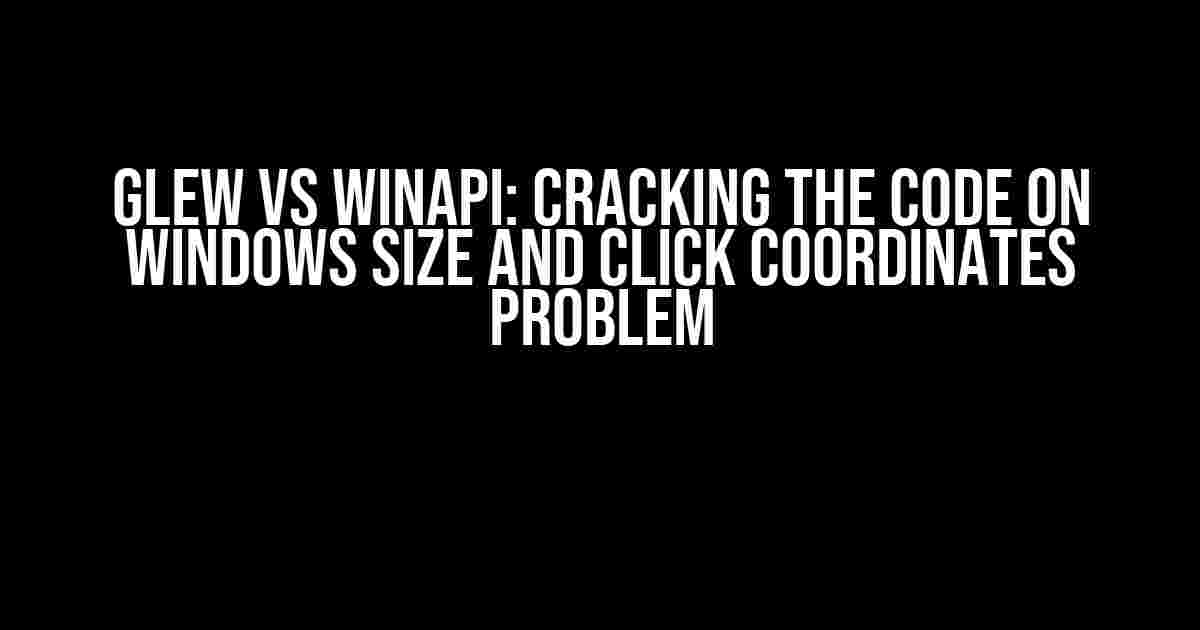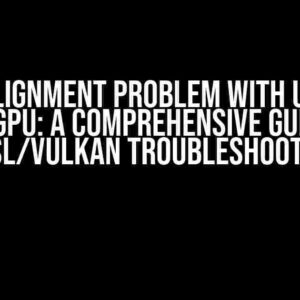Are you tired of wrestling with GLEW and WinAPI, only to find yourself stuck on the windows size and click coordinates problem? Fear not, dear developer, for this article is here to guide you through the trenches of these two powerful tools and help you emerge victorious on the other side.
What is GLEW and Why Do I Need It?
GLEW (OpenGL Extension Wrangler Library) is a cross-platform library that provides a simple and easy-to-use interface for accessing OpenGL extensions. Essentially, it helps you tap into the power of OpenGL without having to write a ton of boilerplate code. With GLEW, you can focus on creating stunning 3D graphics and games, rather than getting bogged down in the nitty-gritty of extension management.
The Problem with GLEW and Windows Size
So, what’s the issue with GLEW and Windows size? Well, when you create an OpenGL context using GLEW, it can be a bit finicky about window sizes. Specifically, if you try to set the window size programmatically using GLEW, you might run into some weird behavior, such as:
- Windows not resizing correctly
- OpenGL context not rendering properly
- Crashes and errors galore!
This is because GLEW relies on the underlying windowing system to manage the window’s size and position. And, let’s be honest, Windows can be a bit quirky when it comes to window management.
Enter WinAPI: The Savior of Windows-Sized Woes
WinAPI (Windows Application Programming Interface) is a set of APIs provided by Microsoft for developing Windows applications. It’s a powerful tool that gives you low-level access to the Windows operating system, allowing you to tap into its inner workings and bend it to your will.
How WinAPI Solves the Windows Size Problem
WinAPI provides a reliable way to manage window sizes and positions, bypassing GLEW’s limitations. By using WinAPI functions like GetClientRect, GetWindowRect, and MoveWindow, you can programmatically control the window’s size and position, ensuring that your OpenGL context renders correctly and without any issues.
#include <windows.h> // Get the current window handle HWND hwnd = GetForegroundWindow(); // Get the client rectangle (i.e., the area inside the window) RECT clientRect; GetClientRect(hwnd, &clientRect); // Set the window size using the client rectangle MoveWindow(hwnd, 0, 0, clientRect.right - clientRect.left, clientRect.bottom - clientRect.top, TRUE);
The Click Coordinates Conundrum
Another common issue when using GLEW and OpenGL is dealing with click coordinates. You see, OpenGL uses a different coordinate system than Windows, which can lead to some headaches when trying to handle mouse clicks and events.
GLEW’s Coordinate System
In GLEW, the coordinate system is based on the OpenGL viewport, which can be different from the Windows coordinate system. This means that when you click on a button or object in your OpenGL scene, the click coordinates need to be converted from the Windows coordinate system to the OpenGL coordinate system.
// Get the mouse position in Windows coordinates POINT mousePos; GetCursorPos(&mousePos); // Convert the Windows coordinates to OpenGL coordinates GLfloat mouseX = (GLfloat)mousePos.x / (GLfloat)width; GLfloat mouseY = (GLfloat)mousePos.y / (GLfloat)height; // Use the converted coordinates in your OpenGL code // ...
WinAPI to the Rescue (Again!) with GetCursorPos
WinAPI provides the GetCursorPos function, which retrieves the current cursor position in Windows coordinates. By using this function in conjunction with GLEW, you can accurately convert click coordinates from the Windows coordinate system to the OpenGL coordinate system.
Putting it All Together: A GLEW and WinAPI Mashup
So, how do you bring GLEW and WinAPI together to create a seamless and error-free experience? Here’s a step-by-step guide to help you get started:
- Create an OpenGL context using GLEW
- Get the current window handle using
GetForegroundWindow - Use WinAPI functions to manage the window size and position (e.g.,
GetClientRect,GetWindowRect, andMoveWindow) - Handle click events using
GetCursorPosand convert the coordinates to the OpenGL coordinate system - Use the converted coordinates in your OpenGL code to handle clicks and events
| Function | Description |
|---|---|
GetForegroundWindow |
Retrieves the current foreground window handle |
GetClientRect |
Retrieves the client rectangle (i.e., the area inside the window) |
GetWindowRect |
Retrieves the window rectangle (i.e., the entire window area) |
MoveWindow |
Moves and resizes the window |
GetCursorPos |
Retrieves the current cursor position in Windows coordinates |
By following these steps and using the power of WinAPI to augment GLEW, you’ll be well on your way to creating stunning 3D graphics and games that run smoothly and efficiently on Windows.
Conclusion
In conclusion, GLEW and WinAPI might seem like two separate entities, but they can work together in harmony to create a seamless and powerful development experience. By understanding the limitations of GLEW and leveraging the strengths of WinAPI, you can overcome the windows size and click coordinates problem and unlock the full potential of OpenGL on Windows.
So, go ahead and give it a try! With this article as your guide, you’ll be creating breathtaking 3D graphics and games in no time. Happy coding!
Frequently Asked Question
Get the scoop on GLEW vs WinAPI, and the common conundrums surrounding window size and click coordinates!
What’s the main difference between GLEW and WinAPI?
GLEW ( OpenGL Extension Wrangler Library) is a cross-platform library that helps access OpenGL extensions, whereas WinAPI (Windows Application Programming Interface) is a set of APIs for creating Windows applications. GLEW is primarily used for OpenGL development, while WinAPI is for building Windows-specific applications. Think of GLEW as the magic that makes your graphics sparkle, and WinAPI as the foundation that holds your Windows app together!
Why do I need to use GLEW with OpenGL on Windows?
On Windows, the OpenGL driver only provides access to the core functions, and not the extensions. GLEW fills this gap by providing a convenient way to access these extensions, making it a must-have for any serious OpenGL development on Windows. Without GLEW, you’d be limited to the core functions, which would severely restrict your graphics capabilities.
How do I handle window size changes with GLEW and WinAPI?
When the window size changes, you need to update the OpenGL viewport and projection matrix accordingly. In GLEW, you can use the glViewport function to set the new viewport dimensions. With WinAPI, you’ll need to handle the WM_SIZE message and update the window’s client area. Don’t forget to call glutReshapeFunc (if using GLUT) to update the OpenGL context!
Why are my click coordinates off when using GLEW and WinAPI?
This can happen due to the differences in coordinate systems between GLEW (OpenGL) and WinAPI. OpenGL uses a right-handed coordinate system, while WinAPI uses a left-handed system. To fix this, you’ll need to flip the y-coordinate of the mouse click event. You can do this by subtracting the y-coordinate from the window’s height. Problem solved!
Can I use GLEW and WinAPI together for a Windows-specific OpenGL application?
Absolutely! In fact, GLEW is often used in conjunction with WinAPI for building Windows-specific OpenGL applications. You can use WinAPI to create the window and handle events, while relying on GLEW to access OpenGL extensions and create stunning graphics. By combining these two powerhouses, you’ll be able to craft a high-performance, visually stunning application that takes full advantage of the Windows platform.


